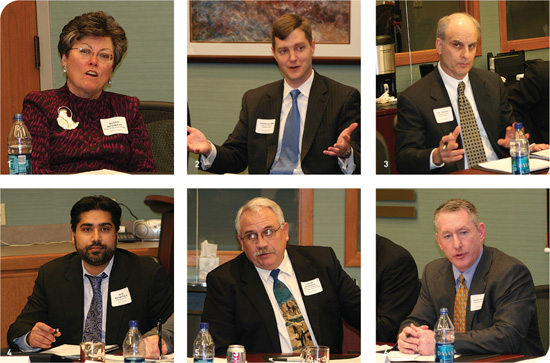
1: Susan McGreevy said a long-overdue sense of fiscal responsibility had returned to project assessment in the construction field.
2. The federal government, through the General Services Administration, had been effective in keeping money flowing to the industry, said Jason Klumb. | 3. In a new lending dynamic, said Tom Vrabac, it was necessary to “get comfortable with value” because the market had been restructured. | 4. When private-sector work returns, you’ll know the recovery is real, said Rick Maniktala. | 5. David Kendrick cited concerns about the loss of key employees during the construction down spell. | 6. Agreed, said Scott Vath: A major challenge in a recovering sector will be “getting the right people on board.”
Randy Bredar observed that his firm, J.E. Dunn Construction, had twice the backlog for this year as it did in 2010. For Dunn, diversification has been the key. “Our ability to be able to move resources to different markets and client sectors has really been a benefit for us,” said Bredar.
Doug Irvin of the Lockton Companies tagged 2012 or 2013. From conversations with the firm’s clients around the country, he noted that the backlogs in the design community were finally starting to increase. As he sees it, firms are not necessarily adding staff, but they are not laying off staff, either.
“We believe the architectural/engineering community has stabilized,” agreed David Rezac of 360 Architecture. When recovery does become real, he expects that it will be a more incremental recovery than in the past.
“When we sit down to have renewal discussions,” said Teresa Martin also of Lockton, “and people stop talking about reductions in their backlog and reductions in payrolls, I will feel that recovery is on its way.”
Susan McGreevy, a lawyer with Stinson Morrison Hecker, is reviewing more contracts for new work than she has in a long time. The activity she is seeing is on the private side. “There are people with money on the sidelines,” she observed, “and they are thinking, ‘the interest isn’t going to get any lower and the contractors aren’t going to get any more desperate, so let’s get going.’”
“I think the recovery will be real when that private-sector work comes back,” attested Rick Maniktala of the M.E. Group, a consulting engineering firm. The federal work is what has sustained his company in the interim.
Jason Klumb, regional GSA director, elaborated on the nature of that federal work. He noted that the GSA had worked aggressively to support the president’s stimulus package. “We are moving projects through,” he noted, “and I believe and hope some of you are the recipients of some of that work.”
“There is work out there,” said Biondo. “I think that some folks just aren’t looking at some of that work that is available to them.” She cited federally funded projects and “necessity work” in the private sector.
Ramping Up
Given the consensus that recovery is in progress or very nearly so, Rosie Privitera Biondo asked her colleagues what they needed to do to be ready when it arrives.
From his perspective with Grandbridge Real Estate Capital, Tom Vrabac saw the need for lenders to “get comfortable with value.” As he explained, the precipitous drop in commercial real estate values over the past two or three years unnerved the investment community. As the capitalization rates begin to stabilize, he believes the lenders will begin to come around.